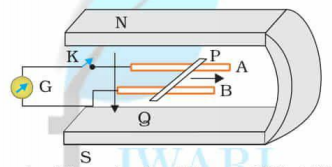Q 14. In the given figure we have a metal rod PQ which is put on the smooth rails AB and these are kept in between the two poles of permanent magnets. All these three (rod, rails, and the magnetic field ) are in mutually perpendicular direction. There is a galvanometer ‘G’ connected through the rails by using a switch ‘K’.Given, Rod’s length = 15 cm , Magnetic field strength, B = 0.50 T, Resistance produced by the closed-loop = . Let’s consider the field is uniform.

(i) Determine the polarity and the magnitude of the induced emf if we will keep the K open and the rod will be moved with the speed of 12 cm/s in the direction shown in the figure.
(ii) When the K was open is there any excess charge built up? Assume that K is closed then what will happen after it?
(iii) When the rod was moving uniformly and the K was open, then on the electron in the rod PQ there was no net force even though they did not experience any magnetic field because of the motion of the rod. Explain.
(iv) After closing the K, calculate the retarding force.
(v) When the K will be closed calculate the total external power which will be required to keep moving the rod with the same speed ( 12 cm/s)? and also calculate the power required when K will be closed.
(vi)What would be the power loss ( in form of heat) when the circuit is closed? What would be the source of this power?
(vii) Calculate the emf induced in the moving rod if the direction of the magnetic field is changed from perpendicular to parallel to the rails?
Length of the rod, l = 15 cm = 0.15 m
Strength of the magnetic field, B = 0.50 T
Resistance produced by the closed-loop, null
(a) Induced emf= 9 mV; the polarity of the induced emf is such that end P shows positive while end Q shows negative ends. Speed of the rod, v = 12 cm/s = 0.12 m/s Induced emf is given as: e = Bvl
The polarity of the induced emf is such that end P shows positive while end Q shows negative ends.
(b) Yes; when key K is closed, excess charge is maintained by the continuous flow of current.
When key K is open, there is excess charge built up at both ends of the rods.
When key K is closed, excess charge is maintained by the continuous flow of current.
(c) Magnetic force is canceled by the electric force set-up due to the excess charge of opposite nature at both ends of the rod. There is no net force on the electrons in rod PQ when key K is open and the rod is moving uniformly. This is because the magnetic force is canceled by the electric force set-up due to the excess charge of opposite nature at both ends of the rods.
(d) Retarding force exerted on the rod, F = IBI
Where,
l= Current flowing through the rod
(e) 9 mW; no power is expended when key Kis open.
Speed of the rod, v = 12 cm/s = 0.12 m/s
Hence, power is given as:
when key K Is open, no power is expended.
(f) 9 mW; power is provided by an external agent.
Power dissipated as heat
The source of this power is an external agent.
g) Zero
In this case, no emf is induced in the coil because the motion of the rod does not cut across the field lines.